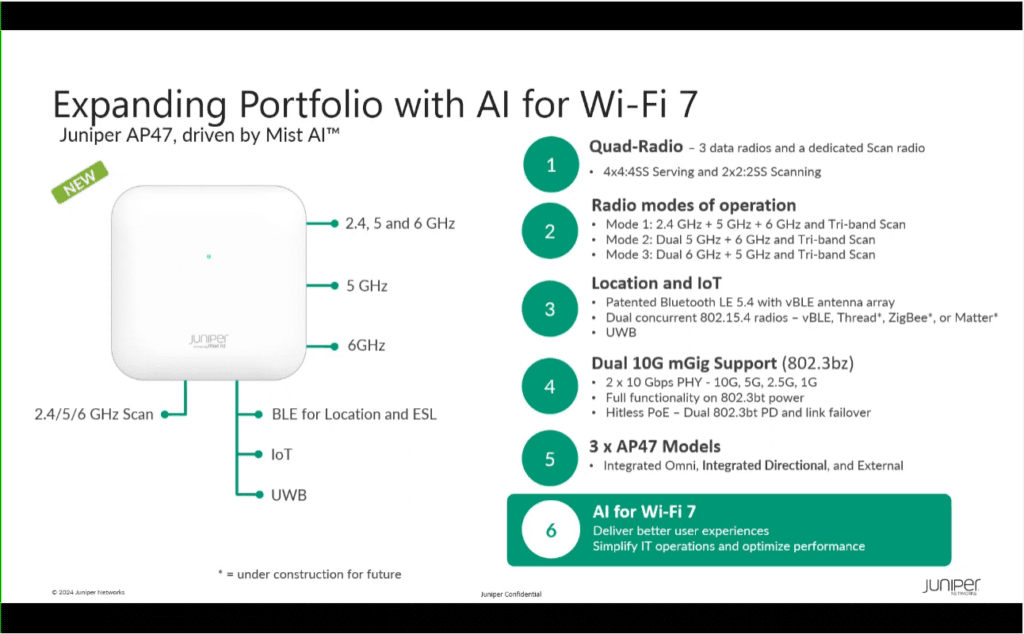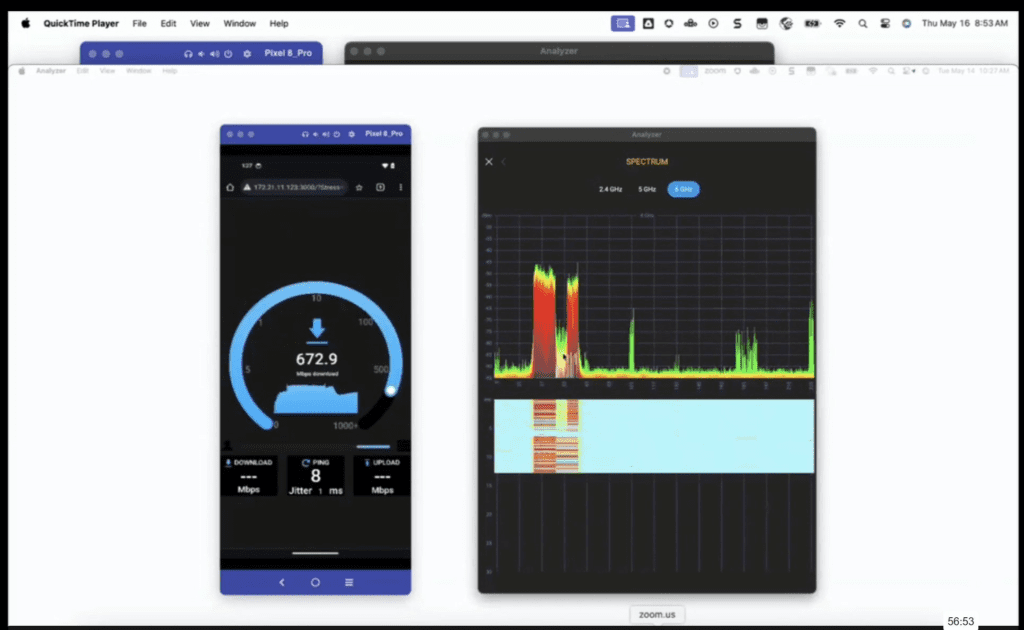Today was a new product announcement, a brand new Mist AP47 with WiFi 7 and a bunch more IOT options from Juniper Networks. Recently, Ali and I, from Towers Edge were joined by some fellow Juniper MistFits and members of the Juniper team to discuss that new product. You can watch that on our Youtube channel.

Four years ago, during the heat of COVID lock downs, 6GHz WiFi was announced by the FCC as the next big thing in WiFi. Supply chain issues were just beginning and radios that supported the new technology from the big vendors were still a ways out. I remember sitting in my home office watching, as many of us did, the Good News videos by actor John Krasinski, that gave us a moment of relief from the reality we were facing. No matter how you fall on the spectrum of those lock downs, 6GHz changed the game.
During the times of supply chain issues, getting even WiFi 6 or older APs was a challenge. I work, during my day job, for a bunch of school districts and had one of the most challenging of jobs in the later quarters of 2020 to purchase and install thousands of Juniper Mist, HPE Aruba, Cisco, Ruckus, and Ubiquiti APs across my school districts in a matter of three months with COVID CARES funding. In a future blog post, I’ll write about that experience from a Juniper perspective, as Juniper Mist is my favorite vendor.
Skipping Over WiFi 6e And Moving to WiFi 7
During those lockdowns, one thing that was common amongst many tech pundits in our WiFi industry was a feeling of waiting for WiFi 7 because of how challenging it was to obtain WiFi 6 and WiFi 6e radios. Everyone said they were going to skip over WiFi 6 and WiFi 6e for WiFi 7. That fervor has died down lately, but is being rekindled with the final release of WiFi 7 APs from the big vendors.
Juniper Mist was selected by many of my smaller school districts during that period of supply chain issues. At the time, only WiFi 6 AP43, AP33, and AP32 were available for purchase as the AP45 wasn’t announced for a couple more years. So we bought and installed hundreds of AP43s, AP33s, and AP32s.
Schools in the United States operate on schedules of 5 years for a lot of their networking equipment as Federal Erate Grants are awarded every 5 years. That means we are still within our 5 year window of those deployed WiFi 6 APs. This coming year, my schools will be approaching the Erate window again and needing to upgrade. I’ve been anxiously awaiting Juniper Mist releasing a WiFi 7 AP that is a worthy replacement for our WiFi 6 APs. I wasn’t planning on skipping WiFi 6e, but it looks like that may be the case because of Juniper Network’s latest announcement.
Juniper Mist WiFi 7 AP47
Today, Juniper announced their brand new flagship WiFi 7 AP47.

I was lucky enough to hold a beta AP47 in my hand under strict NDA at Mobility Field Day 11 back in May. Anticipation for this announcement made me super excited to see the the AP47 hardware running the latest Mist AI code, plus all the new radios Juniper is including in the AP47.
Let’s dig into the details of what was announced today.

The AP47 comes in three models, the AP47, AP47D, and AP47E with different antenna patterns, including external and internal options. The AP47 is a 4×4 MIMO AP that has three 4×4:4SS serving radios and one dedicated 2×2:2SS scanning radio. You can operate with regular mode of 2.4GHz + 5GHz + 6GHz in a Tri-Band operation.
You can also select either Dual 5GHz + 6GHz Tri-Band or Dual 6GHz + 5GHz Tri-Band configuration, a first for Juniper Mist APs. This allows sites with higher capacities needs to design appropriately.

The AP47 is a true IOT radio as well as WiFi AP, as it contains a vBLE 5.4 Antenna Array radio and dual 802.15.4 IOT radios for future development of Thread, Zigbee, or Matter, adds a new Ultra Wide Band (UWB) location radio for AP placement and IOT use cases, and a GPS L1/L5 for AP location for Standard Power AFC operations and auto geo location services.
For Standard Power AFC operation, the internal antennas are set as low power by default but can be configured to use AFC for standard power. The models that have hardened external antennas will use AFC for standard power by default. The GPS module aids with the AFC location.

The dual ethernet ports are also getting an upgrade to 10 Gigabit. The AP47 can operate on POE+ but will reduce functionality if lower than 802.3bt POE++ is supplied to the AP. Both ethernet ports can operate with Hitless POE for Dual POE++ and/or Link Failover including between different switches for redundancy.
WiFi 7 Capabilities
Lastly, as expected from all Juniper Mist APs, Juniper is bringing Mist AI for WiFi 7. Mist AI adds additional capabilities for analyzing your WiFi networks with the smarts of Marvis.

There a few high profile settings that are expected when you talk about WiFi 7, specifically Multi-Link Operation (MLO), Multi-Link Devices (MLD), Preamble Puncturing, 4K QAM and 320MHz wide channels. As expected, Juniper announced that the AP47 supports all of these anticipated features.

Multi-Link Operation and Multi-Link Devices (MLD) enable WiFi 7 capable APs and devices that have multiple radios to communicate in a couple ways. This was best explained a few weeks ago by Peter Mackenzie and Wes Purvis during Juniper’s webinar about WiFi 7. The basics come down to two versions of MLO, either Multi-Link Single-Radio (MLSR) OR Multi-Link Multi-Radio (MLMR) as show in this slide from that webinar.

Multi-Link Single-Radio
MLSR allows the AP and client to transmit and receive on multiple bands but only one at a time. The device will switch back and forth between bands based upon a pre-determined schedule. This is similar to Time Division Duplex scheduling in the cellular world, but only in the fact that the band usage is determined by a schedule. It does not schedule which client will transmit as they have to follow the CSMA-CA game as all existing WiFi clients. This helps WiFi 7 improve lower latency on the links as you can use the Band that has the least usage or interference.
Multi-Link Multi-Radio
MLMR provides multiple channels for AP and Client to communicate across at the same time. This is approaching Frequency Division Duplexing (FDD) in the cellular world, but like MLSR above, does so only in frequency planning. The clients and AP communications are not scheduled link cellular communications and have to follow the CSMA-CA game as well. This is the feature most people think of when they hear about MLO. The AP47 can operate with MLMR across the 2.4GHz, 5GHz, and 6GHz bands based upon configuration.
Preamble Puncturing
When using larger channels widths, WiFi may have interference within a section of the channel. Larger channels means an increased probability of interference. That’s why we’ve followed the recommendations to use 80MHz wide channels in 5GHz until you can’t, then to use 40MHz wide channels then 20MHz wide channels. Most organization use either 40MHz and 20MHz, leaving 80MHz for home and small business use cases.

Preamble Puncturing attempts to solve part of this issue. The WiFi 7 device can attempt to use the full channel but recognize interference on a 20MHz section of the 80MHz wide channel. The device can then adjust and use 60MHz of the 80MHz channel and leave the interference filled 20MHz section, thus utilizing more of the channel.
This enables a more efficient use of the spectrum and the ability to use wider channel widths in our designs. Previous generations of WiFi require the whole channel to be clear of interference before a client or AP can broadcast. The AP47 can do Preamble Puncturing when used with wider channel widths such as 80MHz, 160MHz, or 320MHz. This feature will probably be used more in 6GHz or smaller deployments of 5GHz.
Anticipation for the AP47
Ever since those days on social media discussing the question of waiting for WiFi 7, I have been anticipating the release of the new AP47. At the time, I didn’t understand the capabilities that were being developed for the WiFi 7 standard. Now that I know what those capabilities are, I’m excited to deploy them. Many of the new WiFi 7 features, such as 4K QAM, will largely be used in small or home environments, but they bring some possibilities that may be useful in enterprise and school networks. The bigger beneficial capability is the expansion of the 6GHz band from WiFi 6 to WiFi 6e and now WiFi 7. (Be aware that WiFi 7 does not necessarily include 6GHz unlike WiFi 6e.)
Juniper Mist is bringing enough extra features that make the AP47 worth waiting for. If I had Juniper AP45s deployed across my schools, I probably would stick with what I have deployed. Because of Erate timeframes, that hasn’t happened. So, waiting for the AP47 makes it a no brainer of what to upgrade to next year. The only thing I’m waiting on is the price that hasn’t been announced yet.
I’m of the mindset of purchasing the best gear I can get because it will be sitting in the challenging school environments for at least 5 years. In that timeframe, we are scheduled to have WiFi 8 products come to market. You can always make the plan to wait for the next iteration but then you’ll miss out on the features of the current generation.
If you’ve been skipping over WiFi 6 or WiFi 6e in anticipation of WiFi 7.. your wait is over with the Juniper Mist AP47.

